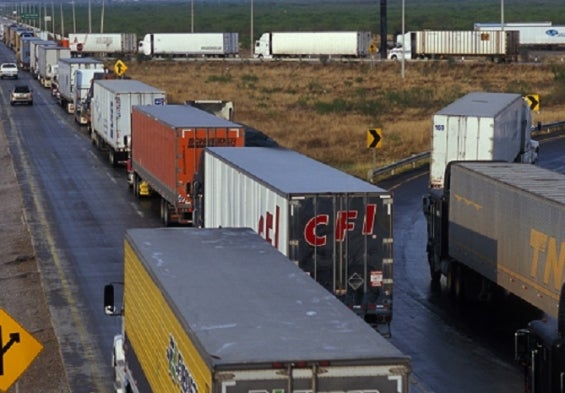Headline News | Press Releases
Teamsters, Advocates Sue U.S. DOT For Not Issuing Truck Driver Training Requirements

A federal appellate court should order the U.S. Department of Transportation (DOT) to issue a long-overdue rule outlining training standards for entry-level truck drivers, safety advocates and a union told the court in a lawsuit filed today.
Congress initially told the agency to finish a rulemaking process on driver training by 1993, but the agency still has not done so.
Advocates for Highway and Auto Safety, Citizens for Reliable and Safe Highways (CRASH), and the International Brotherhood of Teamsters filed the suit in the U.S. Court of Appeals for the District of Columbia against the DOT and the Federal Motor Carrier Safety Administration (FMCSA), the agency charged with issuing the rule. Public Citizen is representing the groups.
“People are dying needlessly while the agency drags its feet,” said Henry Jasny, senior vice president and general counsel with Advocates for Highway and Auto Safety. “New truck drivers need to be properly trained before they get behind the wheel. This is a dereliction of the agency’s duty.”
“Enough is enough,” said Adina Rosenbaum, attorney for Public Citizen. “Twenty years, two lawsuits and two congressional mandates have not been successful at prodding the DOT into issuing the entry-level driver training rule. The court should step in and order the agency to act.”
There are 3.9 million commercial motor vehicle drivers in the U.S. with commercial driver’s licenses, and new drivers get on the roads daily. Drivers need only receive 10 hours of classroom lectures and pass a test to get their commercial driver’s license to drive a truck.
Large trucks that can weigh up to 40 tons when fully loaded are more complicated to operate than automobiles. Inexperienced truck drivers have higher crash rates and should have hours of supervised, behind-the-wheel training before they are allowed on the highways.
Approximately 4,000 people die and nearly 100,000 more are injured annually in truck crashes, according to government data. Large truck crash fatalities increased by 4 percent in 2012. This follows a 2 percent increase in 2011 and a 9 percent increase in 2010, despite a decline in overall motor vehicle deaths. Further, there was an 18 percent increase in 2012 of those injured in large truck crashes. The annual cost to society from large truck crashes is estimated to be more than $99 billion.
Dorothy Wert’s husband, David Wert, Sr., was killed in 2011 in a truck crash caused by an inexperienced truck driver who left his broken-down truck parked in the middle of a dark Pennsylvania highway at 3 a.m. with no lights on and no warning signals or flares. After the crash, David, a truck driver with 35 years of experience, managed to drive his truck safely onto the side of the road in spite of suffering fatal injuries.
“We have waited far too long for a requirement to ensure that truck drivers know what they are doing and have been tested before we allow them behind the wheel of an 80,000 pound truck,” said Wert, a CRASH volunteer advocate who lives in Montrose, Pa. “Truck drivers should not be allowed to drive without a required understanding of the regulations and a minimum number of training hours behind the wheel. I know that my husband would be alive today if the driver that caused Dave’s crash had been better trained, had more experience and had taken the proper precautions.”
“Proper training is absolutely necessary for new drivers to operate their rigs safely,” said Jim Hoffa, Teamsters general president. “The agency is shirking its responsibility by not issuing this long-overdue rule.”
The path to the rule has been long. In 1991, concerned about truck crashes, Congress passed a law requiring the DOT to complete a rulemaking by 1993 on the need to require training of entry-level commercial motor vehicle operators.
In 2002, when no rule had been issued, safety advocates went to court to force the agency to act. The DOT agreed to issue the rule by 2004. While it did issue a rule that year, the rule was grossly inadequate, requiring only 10 hours of classroom lectures, none of it on-the-road training. That is the rule that is still on the books.
Safety advocates returned to court, and in 2005, the court ruled that FMCSA had disregarded volumes of evidence that on-street training enhances safety. In 2007, the DOT issued another proposed rule, but the agency never finished it.
In 2012, Congress passed a second law (the “Moving Ahead for Progress in the 21st Century Act” also known as MAP-21) requiring the DOT to issue the entry-level training rule, this time by Oct. 1, 2013. Congress specified that the rule had to include behind-the-wheel training.
During the next year, FMCSA held listening sessions. Then, on Sept. 19, 2013, it withdrew the 2007 proposed rule that had been in limbo and said it was going back to the drawing board. On Aug. 19, 2014, FMCSA published a notice indicating it had not begun work on the new rule and did not intend to anytime soon. Instead, it said that it was exploring conducting a negotiated rulemaking, and that it had hired a “neutral convener” who would interview all concerned parties, balance all the interests and issue a report before the agency decided what type of rulemaking to undertake. No timetable was given for completion of the rule.
“The FMCSA’s inaction to release a new notice of proposed rulemaking for entry-level driver training is perpetuating a hazard for everyone on our roadways by permitting inexperienced drivers to interact with the unknowing public,” said John Lannen, executive director of the Truck Safety Coalition, a partnership between CRASH and Parents Against Tired Truckers. “This hazard will only grow in scope as the turnover rate for truck drivers continues to remain extremely high – over 90 percent – and the current truck driver work force ages out.”
Read the lawsuit here: http://www.citizen.org/documents/in-re-advocates-for-highway-and-auto-safety-petition-for-writ-of-mandamus.pdf.